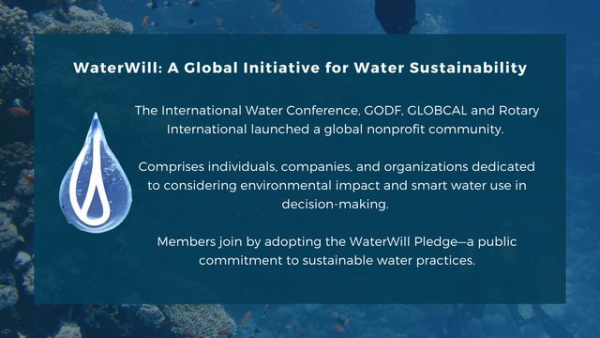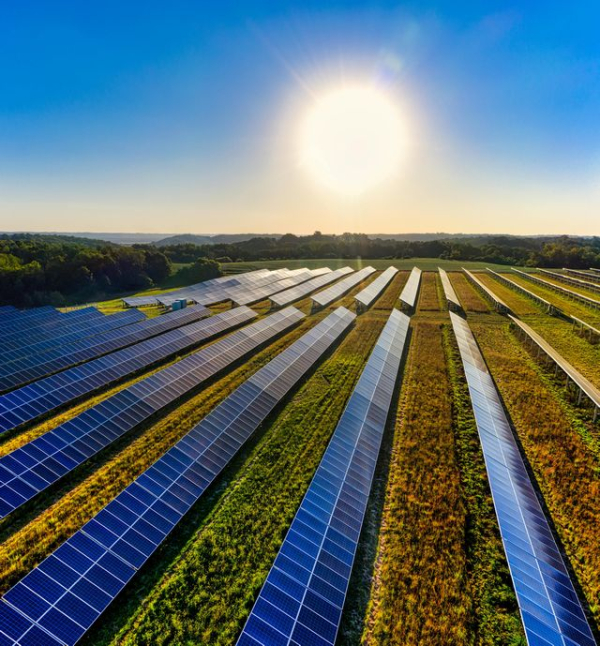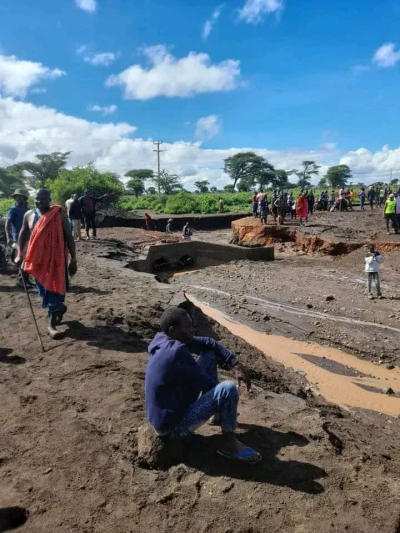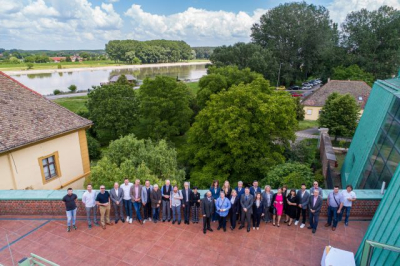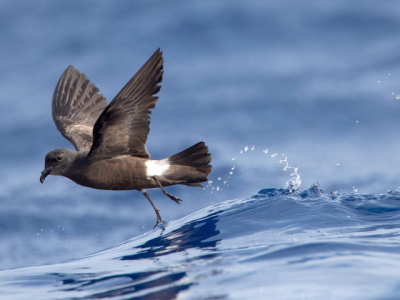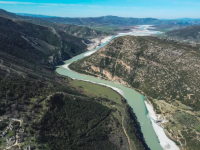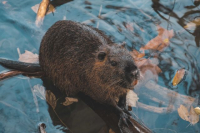What is WaterWill?
WaterWill is the global initiative of the International Water Conference, GODF and Rotary International as a global nonprofit community of individuals, companies and organizations that promised to consider the environment and smart use of water when they take decisions.
To be part of the community and to use the WaterWill logo, the individual or the company/organization adopts a pledge (the public promise through a public acceptance and obligation to follow the guidelines of the WaterWill Pledge) to consider environmental aspects and impacts in its activities and decisions. It’s a global action and initiative taken to raise widest possible awareness on importance to preserve water.
What is the mission of WaterWill?
WaterWill aims to raise awareness and help individuals, businesses and organizations to take simple, economical and incentivized measures to become more water-cautious and eco-friendly. Recognizing that the individual steps of a large number of actors can lead to significant improvements in preservation and smart use of our water resources to help our environmental sustainability, WaterWill empowers individuals, businesses and organizations on the one hand, and consumers and the general public on the other, to take mutually reinforcing steps to ensure a greener future and enough clean water for all.
Who can join WaterWill?
Any individual, company or organization, formal or informal, can join its network, since environmental consciousness has no boundaries. A group of friends or a smaller unit of a large organization (like people working in the same office or a certain division) can live according to the WaterWill Policy, similarly to a huge multinational corporation, or even a country.
Is WaterWill a certification?
No, WaterWill is the exact opposite of a certification, and does not provide a certificate. It provides Smart Water Use Guidelines to pledgers and an easy way for them to publicly show their commitment to sustainable practices through a WaterWill Policy. WaterWill is compatible with any other certification or environmental policy that an organization might have. It is a promise to respect the environment, make that commitment public, and promote smart use of water with environmentally sustainable practices.
What are the differences between a certification and WaterWill?
A certification is a formal declaration (issued by a certifying body) that a company or organization meets certain criteria.
The WaterWill Pledge (the public WaterWill Policy) is a “promise” to consider the smart use of water and overall environment when taking decisions.
Both a certification and the WaterWill Policy are imperfect (there are no perfect things in this world), but they can easily complement each other, being WaterWill the first step as it does not require any financial investment.
What is the Pledge?
The WaterWill Pledge (the public WaterWill Policy) is a “promise” that individuals, businesses and organizations take to improve their environmental impact through smart use of water.
How much does it cost?
Nothing. WaterWill and all its procedures and information are free (distributed and freely available just like the free software). The only cost of its adoption is maybe some meetings with the staff and the colleagues involved.
Will WaterWill remain free?
Yes, as a voluntary nonprofit global initiative, WaterWill is and will always be free.
How can I support WaterWill?
There are many ways to support WaterWill. Organizations and Individuals can register and encourage their partners to register as well. Anyone can become a WaterWill volunteer or intern to help undertake outreach, develop local strategies, and help WaterWill succeed in its mission.
For financial or in-kind contributions, some info are available at ( waterwill.org/donations f.e.)
How do you plan to target underdeveloped countries where people may lack resources to adopt environmentally sustainable practices?
WaterWill is a global initiative which aims to change people’s mentality towards the environment and promote environmentally sustainable practices. Unfortunately, in some parts of the world there may be other priorities and fundamental needs to be fulfilled prior to environmental concerns. It is also true, though, that many times these countries are also the ones facing the greatest environmental challenges. WaterWill requires very small steps which are easy to implement and free to adopt. Therefore, it will be possible to make an impact in developing countries where other organizations/associations have not yet succeeded.
After a registrant has fulfilled all the promises in the WaterWill Policy and has fully adopted the Guidelines, what comes next?
After an individual or organization has fully adopted the WaterWill Guidelines, it is strongly encouraged to invite its friends, partners and stakeholders to join as well. In an ideal world, a company would require its partners and suppliers to have a valid public WaterWill Policy.
What is a WaterWill Policy?
The WaterWill Policy is a pledge and a promise to be environmentally aware, and to respect the environment in daily practices and activities. Through the WaterWill Policy, the individual or organization makes public its commitment to a smart use of water resources and greener environment and promises to do its best to implement green practices and encourage others to do the same.
What are the WaterWill Guidelines?
The WaterWill Guidelines are a periodically updated brief set of tips (usually between 10-20) developed by WaterWill. They have been formulated based on extensive in-house research of global best practices regarding smart use of water resources and environmental policies. They are applicable to multinational entities, small & medium-sized firms, organizations, government bodies and individuals. The Guidelines are free.
Harnessing Solar Power to Harvest Water from the Air
Researchers at Shanghai Jiao Tong University have developed a revolutionary solar-powered atmospheric water harvesting technology that holds immense potential for addressing water scarcity in arid regions. The key to their success lies in a super hygroscopic gel synthesized using plant derivatives and hygroscopic salts. This gel boasts an unparalleled water absorption capacity, with one kilogram of dry gel capable of adsorbing 1.18 kilograms of water in arid environments and up to 6.4 kilograms in humid conditions.
What sets this technology apart is its simplicity and cost-effectiveness, making it suitable for large-scale production. Unlike previous challenges faced by researchers, where injecting salt into hydrogels led to reduced swelling capacity, this new gel maintained excellent swelling and salt-trapping properties even with high salt content.
"This atmospheric water harvesting technology can be used to increase the daily water supply needs, such as household drinking water, industrial water, and water for personal hygiene," explains lead author Ruzhu Wang.
Innovative Design for Optimal Water Recovery
The research team also introduced a prototype featuring desorption and condensation chambers configured in parallel. They incorporated a turbofan in the condensation chamber, achieving a remarkable recovery of desorbed water exceeding 90%. Notably, outdoor prototype demonstrations revealed the system's ability to release adsorbed water even in weak sunlight conditions, demonstrating its reliability throughout the day.
Looking ahead, the team aims to further enhance the system's performance by achieving simultaneous adsorption and desorption using renewable energy. This optimization will maximize daily water yield per unit mass of adsorbent, ensuring practical applicability in water generation.
Beyond Drinking Water: Diverse Applications
The implications of this technology extend beyond addressing drinking water needs. Sorbent materials with atmospheric water harvesting capabilities could find applications in dehumidification, agriculture irrigation, and thermal management for electronic devices. As over 2.2 billion people currently reside in water-stressed countries, innovations like these play a crucial role in shaping a sustainable future.
Stay tuned to IWConf.org for more updates on groundbreaking technologies that promise to transform the landscape of water-related solutions. Together, let's explore and promote innovations that make a positive impact on water accessibility and sustainability worldwide.
Source: American Institute of Physics
Rising Death Toll Sparks Humanitarian Crisis in the Wake of Unprecedented Flooding
In the aftermath of relentless floods wreaking havoc in Kenya, the death toll has surged to a staggering 20, with the situation growing increasingly dire. Tragically, on Thursday (Nov. 23), eight individuals lost their lives attempting to traverse the swollen Muuoni River in Makueni County, highlighting the severity of the crisis.
The impact of the floods extends beyond the loss of lives, as essential infrastructures lie submerged and villages find themselves engulfed in rising waters. The El Nino phenomenon has particularly ravaged the Coast, Northern, and Central Kenya regions, exacerbating the already precarious conditions.

Recognizing the urgent need for support, the Kenyan government has allocated 2.4 billion Kenyan Shillings (approximately 19 million USD) to aid those affected, as reported by news outlet Nation. Peninah Malonza, the cabinet secretary for East African Community, the Arid and Semi-Arid Lands (ASALs) & Regional Development, emphasized the government's commitment to addressing the crisis head-on.
The humanitarian impact of the flooding extends beyond Kenya, with the UN Office for the Coordination of Humanitarian Affairs reporting that, since October 1, over 100 lives have been lost in the Horn of Africa, and more than 700,000 people have been displaced. The magnitude of the displacement underscores the urgent need for international attention and collaborative efforts to alleviate the suffering of those affected.
As we grapple with this unfolding crisis, our thoughts are with the communities facing unprecedented challenges. In solidarity with the affected regions, our website is committed to raising awareness, mobilizing resources, and facilitating contributions to support the ongoing relief efforts. Together, we can make a meaningful impact and stand united against the devastating consequences of the floods in Kenya and the broader Horn of Africa.
IWC 2023 - Regional Cooperation in Addressing Water Arsenic & Contamination Issues
Croatia, Serbia, and Hungary will continue their joint efforts in removing arsenic and other harmful substances from water, as concluded at the International Water Conference (IWC 2023 Osijek) held last weekend in Osijek, Croatia.
The Governors of Rotary District 1913 - Croatia, Ivan Miškulin, 2483 - Serbia and Montenegro, Nikola Božić, and 1911 - Hungary, Laslo Reti, have signed a Declaration of Cooperation, committing themselves to focus on improving water quality in the Pannonian Basin in the coming years, as well as actively participating in global water-related projects.
This decision stems from the International Water Conference - IWC 2023 Osijek, where experts, researchers, and decision-makers highlighted the challenges associated with arsenic and other harmful substances in the water.
The President of the Organizing Committee of IWC 2023, Dragan Dabić, stated that this year's conference "provided a deeper insight into the problems we face, especially in the Pannonian Basin."
"Presented were innovative, feasible, sustainable, locally usable, technological and financial solutions targeting purification, monitoring and water resource management. We hope and believe that challenges can be overcome and that we can ensure clean and safe water where it is currently lacking," said Dabić.
He added that the conference also addressed other aspects, including the right to water, the presence of water in tradition, culture, and religion and in the education of young people and professional leaders who will be able to solve water-related problems in the future.
As he mentioned, "A profound and moving moment of the conference was the exceptional presentation by Moses Keteko from the Rotaract Club Eco Warriors from Nairobi."
"Moses provided us with the foundation to start a project to improve access to drinking water and hygiene in Kenya. His words are the foundation of another common goal supported by the governors, the Rotary Global Grant in Kenya. It will give cleaner water and better health for the Masai community in Kenya," explained the President of the Organizing Committee of the IWC 2023 Conference.
The Water Conference (IWC 2023 Osijek) was in the framework of this year's conference of the Rotary District 1913 Croatia, with Christina Covotsou-Patroclou as the representative of the President of the International Rotary Organization.
A surprising number of drifting sea creatures were found living in the Great Pacific Garbage Patch
Translucent, fragile marine creatures that drift through the sea are riding the motion of the ocean to a destination that’s infamous as a home for trash: the Great Pacific Garbage Patch.
Ocean surface currents have shaped the enormous garbage pile for decades, funnelling human-made debris into a region that extends for hundreds of thousands of square miles in the North Pacific, spanning waters between Hawaii and California.
But that’s not all the currents are transporting. A surprising number of delicate, floating invertebrates, called neustons, are making the Great Pacific Garbage Patch home, according to data from a new study.
In particular, there are violet sea snails in the Janthina genus and bright-blue jellyfish relatives known as sea rafts (Velella genus) and blue sea buttons (Porpita genus).
They’re part of a community of creatures thriving in the 620,000 square miles (1.6 million square kilometres) of plastic debris — an area roughly the size of Alaska — that’s hosting a floating ecosystem.
At the heart of the garbage patch, the abundance of these drifters was comparable to that of neustons in the Sargasso Sea, a region of the Atlantic Ocean named for the quantities of Sargassum seaweed on its surface. The Sargasso was previously the only ocean spot known to host neustons in such high densities, researchers reported Thursday in the journal PLOS Biology.
With neustons so plentiful in the Sargasso, the scientists wondered if there might also be a neuston presence in an ocean region shaped by similar surface current activity: the garbage patch, said marine biologist Rebecca Helm, the study’s senior author and an assistant professor of environmental science at Georgetown University’s Earth Commons Institute in Washington, DC.
The Great Pacific Garbage Patch and the Sargasso Sea are both oceanic gyres — marine zones where multiple ocean currents converge to form a vortex (though the Sargasso Sea is known for its floating algae rather than drifting garbage). There are five main oceanic gyres, and the North Pacific Subtropical Gyre is where the best-known garbage patch lies.
Unlike all other seas, the Sargasso has no land boundaries. It’s defined by ocean currents of the North Atlantic Gyre, which flood the Sargasso with multitudes of floating organisms. Perhaps, Helm told CNN, the whirling currents of the North Pacific Gyre were doing the same thing, carrying marine creatures into the garbage patch along with all the plastic trash. It’s not clear if neustons were collecting there before the garbage patch existed, and other researchers who visited the region in recent years focused on plastic rather than on sea snails and jellies, she added.
“No one was looking for and documenting the surface life that they found,” she said.
But when long-distance swimmer and environmental activist Benoît Lecomte swam through the Great Pacific Garbage Patch in 2019, he and his crew gathered data on floating life as well as drifting litter.
Violet snails in the Janthina genus build floating bubble rafts by trapping air bubbles that they coat with mucus and stick together
In just one day alone, they counted more than 3,000 pieces of plastic, along with a large plastic drum, tangles of rope and multiple “ghost nets” (abandoned fishing nets). Lecomte later told CNN that swimming through the microplastic-filled water was like “looking up at the skies on a snowy day — but in reverse.”
Over the course of the 80-day expedition, Lecomte swam through the plastic-littered water for up to eight hours each day. Meanwhile, the crew was busy collecting samples from the water. In addition to gathering plastic, they towed a small mesh “neuston net” behind their boat to capture the tiny, fragile specimens, which they identified, counted, photographed and then returned to the ocean. Once the journey was over, their data was handed off to the study authors for analysis.
Some of the crew’s trawls captured “a couple of buckets worth” of wee floaters, “more than I’ve seen anywhere I’ve ever been,” said Helm, who didn’t take part in the swim. “The fact that we found so many out in the middle of the ocean was really exciting.”
Helm and her coauthors used computer models to estimate neuston densities in the Great Pacific Garbage Patch, relative to plastic bits and other types of ocean life based on the samples collected by Lecomte and his crew. The study team found that the number of sea snails, sea rafts and blue buttons was even higher in the centre of the patch, where there was more plastic in the water than it was around the edges.
“The sheer abundance was so surprising,” Helm said.
And yet the abundance of these animals in the garbage patch is rivalled by the abundance of plastic — at least 87,000 tons (79,000 metric tons) by some estimates, with microplastics distributed throughout the water column. It’s not yet clear how garbage patch neustons are affected by living amid so much litter, though other marine organisms, such as some types of barnacles, have adapted to live on ocean plastic, so answering that question may not be simple, Helm said.
And because jellies such as Velella and Porpita are a favourite meal for sea turtles and seabirds, those animals might also be encountering and swallowing more plastic if they’re following their food deep into the garbage patch, she added.
In other words, finding lots of neustons in the garbage patch is just the first step; further research will be needed to understand their distribution across the region and how their interactions and ecology are shaped by living in a trash-filled marine neighbourhood, the study authors reported.
“We’re at the very beginning,” Helm said. “This is like discovering life on Mars.”
, CNN
Mindy Weisberger is a science writer and media producer whose work has appeared in Live Science, Scientific American and How It Works magazine.
A tiny Hawaiian island is finally free of invasive rats. Now scientists are trying to coax back lost seabird colonies.
Scientists are rebuilding a seabird paradise on Lehua Island, a small, crescent-shaped volcanic cone 35 kilometres west of Kaua‘i, Hawai‘i. Before the arrival of European explorers in the 1800s, the island’s steep headlands teemed with hundreds of thousands of raucous seabirds, including albatrosses, terns, and petrels, whose guano oozed down bluffs to enrich waters brimming with fish. Native Hawaiians travelled to the rugged island by canoe to fish and gather shellfish. But the ecosystem began unravelling with the introduction of invasive rats that decimated seabird eggs and chicks, rabbits that displaced birds from their burrows and mowed down native vegetation, and plants that colonized the disturbed ground. Seabird numbers plummeted, and some species abandoned Lehua.
Over the past 20 years, however, Hawai‘i’s Division of Forestry and Wildlife has led a concerted campaign of research, hunting, and aerial poisoning to finally drive off the rabbits and rats. The work, conducted with help from the California-based nonprofit Island Conservation, the National Tropical Botanical Garden, the US Coast Guard, and others, is already paying off. The number of ‘ā (the Hawaiian name for red-footed boobies) and other species that survived the invaders are increasing in the state sanctuary, which is uninhabited by people and closed to most visitors.
Lehua’s newly rat-free status makes it a crucial refuge for seabirds, says Sheri Mann, the Hawai‘i Division of Forestry and Wildlife forester overseeing the restoration efforts. The island is a haven for other reasons, too: its steep and rocky coastline climbs to the height of a 60-story building, safeguarding seabird habitat even as seas continue to rise.
Now, Mann and her colleagues are left with an entirely different challenge: how to bring back the seabirds that have long since abandoned Lehua Island, including the ʻuaʻu (Hawaiian petrel), ‘ewa‘ewa (sooty tern), and hinaokū (blue-grey noddy). Fortunately, the scientists have a sneaky plan to lure them in.
The restoration team is deploying wooden seabird decoys surrounded by mirrors and solar-powered speakers that broadcast bird calls from the island’s steep slopes. The sights and sounds are meant to trick passing birds into thinking the island is a busy breeding colony. Scientists have used artificial social signals to deceive birds elsewhere, including on Oʻahu, Hawai’i, where results have been promising.
“We’re also throwing out calls of birds we’re not sure have ever been there,” says Mann. The critically endangered ‘akē‘akē (band-rumped storm petrel) for instance, has been picked up on the island’s listening devices, but scientists aren’t sure if the species has ever lived on Lehua. If they can lure it in, the rat-free island could be a boon to the petrel’s overall survival.
Alongside their deceptive scheme, Mann and her colleagues are also restoring Lehua’s native vegetation as a nesting and rearing habitat—vital for seabird recovery. The work is expensive and difficult. Botany crews travel to the island’s rough shores by boat or helicopter to remove weeds. Some areas are so steep that crews pack native seeds into dissolvable clay balls, then toss or slingshot them onto the bluffs favoured by birds.
To Patty Baiao, who has worked on Lehua since 2016 as a seabird expert with Island Conservation, the biggest threat is reinvasion by rats, or the introduction of other invasive species, such as mongooses, mice, and fire ants, that are widespread across nearby islands. Though access to Lehua is severely restricted, Baiao’s team is drafting a biosecurity plan to prevent restoration crews from accidentally introducing invasives as people move between islands.
But barn owls don’t need to hitch a ride to Lehua Island. The non-native predators fly in from nearby islands at night to prey on eggs and chicks. A single owl can do so much damage that restoration crews use infrared goggles and seabird recordings as lures to hunt the owls at night.
If the scientists’ scheme works, the return of seabirds—and their prodigious poop—should have trickle-down effects around the island. Divers are surveying coral, seaweed, and fish populations to understand how the marine ecosystem might benefit. Baiao and others close to the project, including Native Hawaiian cultural practitioner Sabra Kauka, who has travelled to the island with scientists to provide traditional blessings, say a healthier ocean environment will help maintain traditional fisheries that Native Hawaiians and others rely on today.
Baiao envisions Lehua as a predator-free island where seabirds are once again abundant, and critically endangered species like ‘akē‘akē and ʻaʻo (Newell’s shearwater) find refuge.
Baiao hopes Lehua can be a model for how to tackle challenging restoration work on other important islands. “The beauty of these projects is they build knowledge,” she says. “Each project is a stepping stone to the next.”
Tim Lydon
Climate models warn of more extreme weather events as the world’s ocean surface temperature hits record high
Climate change is not a vague and distant threat anymore, it is happening now, and its consequences are becoming more severe and frequent with each passing day. Rising temperatures, extreme weather events, and natural disasters have become commonplace worldwide. According to the latest reports from around the world, climate change is wreaking havoc on the global weather system, and the news paints a bleak picture of what’s to come.
Examples of these are already all around us. The U.S. state of California has been relentlessly hit by severe weather conditions, including heavy rain, strong winds, and thick snow, over the past three months. The state was previously facing a drought, but these recent events have led to devastating floods, and blizzards that have paralyzed the region, and numerous deaths.
Recently released data indicates that the state has received the most significant snowpack on record. This has prompted discussions with atmospheric and climate scientists, who shed light on the factors driving the surge in wet weather and how the state could be affected by a warmer future.
Add to this scientists’ warning on devastating tornadoes that have ripped through parts of the eastern and southern US could be a sign of the damage that will become more common due to global heating. Over a period of two weeks, more than 50 people have lost their lives due to tornadoes and thunderstorms, with the latest storm system causing widespread destruction in states such as Alabama, Illinois, Mississippi, Tennessee, and Arkansas.
And this is just the United States, many other countries are facing similar weather-related catastrophes like the dry European winter drying canals in Venice and the African coast being hit by the longest-lasting tropical cyclone. US government data has now indicated that the temperature of the world’s ocean surface has reached a record high since the beginning of satellite records, leading to marine heatwaves across the planet.
According to preliminary data released by the National Oceanic and Atmospheric Administration (NOAA), the average temperature at the ocean’s surface has been 21.1C since the start of April, surpassing the previous record of 21C set in 2016 (figure above). Climate scientists warn that this is a concerning trend and could have severe consequences for marine ecosystems and the planet as a whole.
The oceans’ temperature is a particular cause of concern, with recent reports indicating that the world’s ocean surface temperature is headed off the charts. The oceans absorb a significant amount of the heat that is trapped in the Earth’s atmosphere by greenhouse gases. The rising ocean temperatures are not just a threat to marine life and habitats but also have serious implications for human health and food security.
And this is where it makes it scary, all these events are interconnected. Hotter oceans not only have a limited capacity to absorb atmospheric heat, but they also provide more energy for storms, as well as putting ice sheets at risk and pushing up global sea levels, caused by salt water expanding as it warms. Thus the gigantic atmospheric rivers that poured down over California and devastating tornadoes over the mid-western U.S.
And talking about ice sheets, Global warming is accelerating the melting of ice in Antarctica, and the increased amount of freshwater flooding into the ocean is disrupting the flow of the Antarctic overturning circulation. As a result, a major ocean circulation that forms around Antarctica could be headed for collapse, risking significant changes to the world’s weather, sea levels, and the health of marine ecosystems.
Why is this important? You see, the Antarctic overturning circulation is a vital component of a worldwide system of currents that transport heat, oxygen, and nutrients across the planet (figured below). In the vicinity of Antarctica, frigid, saline water descends to depths surpassing 4,000 meters. The descent of the dense, oxygenated water stimulates the deepest movement of the overturning circulation. The water flows north, carrying oxygen and nutrients to the Pacific, Indian, and Atlantic Oceans. A comparable process also takes place off the coast of Greenland.
However, indications suggest that the overturning circulation is decelerating, disrupted by the rising volume of meltwater originating from Antarctica, which is diluting the waters, making them less salty and, therefore, less dense, causing them to sink with reduced force. Additionally, the melting process is intensifying due to elevated levels of greenhouse gas emissions, predominantly from burning fossil fuels, that are heating up the atmosphere and oceans.

And now Climate scientists are also indicating an increased likelihood of an El Niño emerging later this year — a phenomenon characterized by Pacific Ocean warming that can heighten the chances of devastating weather events across the planet. Certain models are suggesting the potential emergence of an extreme, or “super El Niño,” later this year. This variety is distinguished by exceptionally high temperatures in a central area of the Pacific encircling the equator.
The previous super El Niño in 2016 was a contributing factor in driving global temperatures to unprecedented levels, exacerbated by human-induced global warming that triggered floods, droughts, and epidemics. In a recent report, the Bureau of Meteorology in Australia stated that all seven models it evaluated, including those from weather bureaus in the US, Japan, and the UK, indicate that ocean surface temperatures will surpass the El Niño threshold by August.
Needless to say, the latest news from around the world paints a grim picture and highlights the urgent need for action to mitigate the effects of climate change and transition to a more sustainable future. Governments, corporations, and individuals all have a role to play in reducing greenhouse gas emissions, adopting sustainable business practices, and reducing our environmental footprint. It is time for us to take action to secure the future of our planet.
Faisal Khan / Medium
The Albanian government has declared the Vjosa River as the first wild river national park in Europe, following an almost decade-long campaign by environmental NGOs. The Vjosa River is one of the last free-flowing waterways in Europe and is home to over 1,000 animal and plant species, including the critically endangered Balkan lynx and the endangered Egyptian vulture. The river flows 168 miles from the Pindus mountains in Greece through narrow canyons, plains, and forests in Albania to the Adriatic coast.
The creation of the national park is the result of a collaboration between the Albanian government, international experts, NGOs from the Save the Blue Heart of Europe campaign, the International Union for Conservation of Nature (IUCN), and outdoor gear company Patagonia. The 12,727 hectare (31,500 acre) park aims to ensure that the Vjosa River and its unique ecosystems are safeguarded. The park has been given IUCN category II park status, a high level of protection similar to that of a wilderness, covering “large-scale ecological processes”, species and ecosystems, crucial to ensuring dams and gravel extraction are banned. It is expected to be operational in 2024.
The creation of the national park has been described as a “truly historic moment” for nature as well as social and economic development by Albania’s prime minister, Edi Rama. He announced the park at a ceremony at Tepelenë castle overlooking the river, attended by stakeholders and ministers. Rama emphasized that “protecting an area does not mean that you enshrine it in isolation from the economy”, citing that national parks attract 20% more tourists compared with non-protected areas. Albania hopes to regenerate villages in the Vjosa region through ecotourism. The country attracted 7.5 million visitors last year, more than twice its 2.8m population.
The park will encompass the 118 miles of the Vjosa River in Albania, three main tributaries, and some land, including areas at risk of flooding. Phase II will add other tributaries. Unlike the IUCN’s Wilderness Protected Areas, which limit the number of visitors, it will allow recreational tourism and some other activities such as local fishing, particularly for 60,000 residents in the catchment.
The Albanian government is also starting a joint process with the Greek authorities to create the Aoos-Vjosa transboundary park, aiming to protect the entire river across both countries, who agreed in January to sign a memorandum of understanding specifying the next actions.
Boris Erg, director of the European office at IUCN, commended the Albanian government for its leadership and ambition and invited other governments to show similar ambition to protect 30% of the planet by 2030. Europe has the most obstructed river landscape in the world, with barriers such as dams, weirs, and fords, estimated to number more than a million, according to a 2020 EU study in 28 countries. Fragmenting of rivers affects their ability to support life.
Ulrich Eichelmann, a conservationist and founder of Riverwatch and part of the Save the Blue Heart of Europe campaign, praised the creation of the national park as a blueprint for wild rivers elsewhere. He stated that most people in central Europe have never seen a wild, living river, free from human interference, that isn’t diverted or dammed or built up with embankments and where biodiversity is low as a result. In contrast, the Vjosa River is full of complexity and without interference.
Karen McVeigh/The Guardian
The largest river and wetland restoration initiative in history was launched at UN Water Conference
A coalition of six countries, namely Colombia, DR Congo, Ecuador, Gabon, Mexico, and Zambia, have launched the Freshwater Challenge, the largest ever initiative to restore degraded rivers, lakes, and wetlands to tackle the world’s worsening water, climate, and natural crises.
The coalition aims to restore 300,000km of rivers and 350 million hectares of wetlands by 2030, with freshwater ecosystems providing a wealth of benefits to people and nature, including mitigating and adapting to climate change and achieving the Sustainable Development Goals.
A third of the world’s wetlands have been lost over the past 50 years, with rivers and lakes the most degraded ecosystems in the world, pushing fish populations, many of which are vital for community food security, to the brink.
The initiative calls on all governments to commit to clear targets in their updated National Biodiversity Strategies and Action Plans, National Determined Contributions, and National Implementation Plan for the SDGs to urgently restore healthy freshwater ecosystems.
The Freshwater Challenge is a country-driven initiative with an inclusive, collaborative approach to implementation, where governments and their partners will co-create freshwater solutions with indigenous people, local communities, and other stakeholders.
A breeding pair of Eurasian beavers are set to return to west London's Paradise Fields, Ealing, marking the first time in 400 years that beavers will inhabit the area. The conservation groups behind the project received £40,000 from the Mayor of London, Sadiq Khan, to create a publicly accessible reintroduction site. This initiative, which is part of the urban rewilding project, aims to challenge perceptions and demonstrate how beavers can be managed in an urban setting while monitoring the flood mitigation effects.
The project is viewed as an important step in rewilding efforts as wild beaver populations in Kent and Oxfordshire move closer to London. The wetland will provide an opportunity to study how beavers interact with an urban river catchment and with urban communities. The chair of the Ealing Wildlife Group, Dr Sean McCormack, hopes that the project will encourage people to remember how close they once lived alongside these ecosystem engineers.
The Rewild London Fund has supported 22 projects across the capital, including this beaver reintroduction initiative. Khan stated that he is committed to reversing the trends of declining biodiversity and the destruction of nature and that rewilding is an exciting way to create healthier ecosystems and allow humans and wildlife to live together more harmoniously.
Beavers have hunted to extinction in Britain 400 years ago for their fur, glands and meat. However, they have begun to reappear in the country through government-licensed beaver releases within enclosures, as well as illegal releases. In 2022, beavers were given legal protection in England, as they are now recognised as native wildlife. Environmentalists hope that the upcoming beaver strategy will pave the way for these animals to be released to roam wild.
More...
Canada lags behind the U.S. on spending to protect the Great Lakes
The federal government says it's making Canada's largest investment ever in protecting the nation's sources of fresh water — including the Great Lakes.
Commitments announced by the government during U.S. President Joe Biden's visit and in the recent budget bring the federal government's total investment to $750 million, said Environment Minister Steven Guilbeault.
"[It brings] us very close to our commitment to invest $1 billion ... in this mandate. So we're not quite there yet," he told CBC News.
The government announced during Biden's visit it will be spending $420 million to clean up and restore the Great Lakes. That money is part of the $750 million total.
During the 2021 election campaign, the Liberals committed to spending more than $1 billion over ten years to protect and restore freshwater bodies, including rivers, large lakes and the Great Lakes.
Last week's budget earmarked $650 million over ten years for the Fraser River, the Mackenzie River, Lake Winnipeg, the Lake of the Woods, Lake Simcoe, the St. Lawrence River and the Great Lakes.
The money is intended to support monitoring, assessment and restoration work, to prevent the release of harmful chemicals and to reduce the frequency of algae blooms.
Canada's freshwater sources face ongoing threats from plastic and toxic chemical pollution, algae blooms from excessive agricultural fertilizer runoff, and invasive species. In the Prairies, they're threatened by shrinking glaciers and drought.
These threats affect plant and aquatic life and the communities that rely on these bodies of water for drinking water and recreation. Canada is home to 20 per cent of the planet's supply of fresh water; Guilbeault said Canada hasn't always lived up to the responsibility.
And he admits Canada needs to catch up to U.S. investments in freshwater source protection and restoration.
"[The Americans] have, in the past few years, made very significant investments early in the Great Lakes," Guilbeault said. "We had made the commitment to invest more."
Michelle Woodhouse, program manager for water at Environmental Defence, agreed Canada needs to match U.S. efforts to protect the Great Lakes.
"Very fair to say we have been lagging behind," she said, "It has been decades of chronic underfunding."
According to calculations by environmental groups, the United States has invested $3.8 billion US in the Great Lakes Restoration Initiative since 2010. By comparison, the Canadian government has allocated $44.84 million to the Great Lakes Protection Initiative. Even on a per capita basis, Canada is trailing.
Environmental groups and U.S. mayors applauded Canada's funding commitment, despite the gap.
"Representing an international border community on the shoreline of the Great Lakes, I am thrilled to see this kind of cooperation and coordination between the U.S. and Canadian governments to enhance the health of the Great Lakes," said Detroit Mayor Mike Duggan in a statement from the Great Lakes and St. Lawrence Cities Initiative.
The Toronto and Region Conservation Authority (TRCA) manages the nine watersheds that run through the Greater Toronto Area.
In 1987, the Toronto waterfront was named as one of 42 areas of concern by the International Joint Commission. The IJC is a bi-national commission established by Canada and the U.S. to regulate cross-border projects that affect water bodies along the border. The IJC identifies "areas of concern" as locations within the Great Lakes that have experienced high levels of environmental damage.
Since then, the TRCA has been working to clean up Lake Ontario. Although it has made progress, it still has to close beaches occasionally and deal with algae blooms and concerns about wildlife habitat. The TRCA also maintains restrictions on fish consumption.
Namrata Shrestha, a senior manager at the TRCA, said investments by the federal government are welcome.
"We do have a lot of issues with our Great Lake system, especially Lake Ontario," Shrestha said. "There a lot of issues on water quality and its implications on not just the ecosystem per se … but also the cascade effect of it, of what that means for us as a community."
The Toronto waterfront is among 12 of 14 Canadian areas of concern that Environment and Climate Change Canada is promising to clean up by 2030. The department says that over the next decade, it will focus on the following contaminated or degraded areas:
- Thunder Bay
- Nipigon Bay
- Peninsula Harbour
- St. Mary's River
- St. Clair River
- St. Clair River
- Detroit River
- Niagara River
- Hamilton Harbour
- Toronto and region
- Bay of Quinte
- St Lawrence River
Three Canadian areas of concern have already been restored and delisted: Collingwood Harbour, Severn Sound and Wheatley Harbour.
By David Thurton
CBC Senior reporter
Hidroelectrica established a joint venture partnership with Masdar from the United Arab Emirates for the development of renewable energy projects.
Ahead of its stock market listing, Romania’s largest electricity producer Hidroelectrica is founding a renewables firm with Abu Dhabi Future Energy Company – Masdar, ZF reported. The state-owned hydropower producer’s shareholder assembly has supported the initiative. The joint venture would develop, invest in, build and operate green energy facilities, the article reveals.
The government controls 80% of the utility.
In December, Abu Dhabi National Energy Co. (TAQA) and Abu Dhabi National Oil Co. (ADNOC) joined Mubadala Investment Co., the emirate’s investment fund, as shareholders in Masdar. The state-controlled company from the United Arab Emirates has ambitious worldwide ambitions in the renewables business including green hydrogen.
Masdar is expanding its presence in the green energy sector throughout the world
According to Masdar, it operates in more than 30 countries with a portfolio, including investment pledges, of more than USD 30 billion. It pointed to Hywind Scotland, the world’s first floating offshore wind farm, and the Sharjah Waste-to-Energy Project, the first commercial facility of its kind in the Middle East.
Masdar has a stake in the largest wind power plant in Romania’s neighbor Serbia.
Hidroelectrica, which is diversifying its business, has posted a 40% jump in revenues for last year, to EUR 1.85 billion at the current exchange rate, while net income surged 32.7% to EUR 813 million. The company sold 14.33 TWh of electricity, 16% less than in 2021, but the average price spiked 65% to EUR 114 per MWh.
Hidroelectrica is diversifying its portfolio and pledging major investments ahead of its long-awaited initial public offer
The Romanian utility is also entering the green hydrogen sector. It is the most likely candidate to win the concession for Europe’s biggest solar power project, according a report. Hidroelectrica is reviving dormant hydropower projects as Romania is rushing to use grants and soft loans from the European Union’s Recovery and Resilience Facility. One of the endeavors is for two such systems on the Danube, which would be installed in cooperation with Bulgaria.
Minister of Energy Virgil Popescu said earlier that Masdar is interested in investments in energy corridors in Romania. After visiting the UAE, he said he discussed joint endeavors in establishing gas routes from the Persian Gulf, the installation of green energy plants, energy efficiency measures and the introduction of hydrogen.
By Igor Todorović
Balkan Green Energy News
China releases rare fish into Yangtze River
China released 200,000 Chinese sturgeon into the Yangtze River, the country's longest river, on Saturday, as part of its efforts to protect the rare fish.
The first batch of 100,000 fish was released in Yichang City of Hubei Province, with two more batches to follow, said China Three Gorges Corporation, noting that it has conducted the release every year since 1984.
With a history of 140 million years, Chinese sturgeon is among the most ancient vertebrate species on earth and is under Class-A protection in China.
The fish is mainly protected through artificial breeding followed by release into the natural environment.
Sturgeon released this year are between six months to 14 years old, a design aimed at fostering the restoration of the wild population, said Jiang Wei, chief engineer of the company's research center for the species.
Before the release, larger sturgeon nearing sexual maturity were branded with satellite tracers for analyzing environmental impacts on the species' survival in the wild, in order to inform future protection measures.
In recent years, China has put solid effort into ecological conservation along the Yangtze River, with a 10-year fishing ban launched in pivotal waters along the river at the beginning of 2021.
In December 2020, China promulgated the Yangtze River Protection Law, providing legal guarantee for biodiversity conservation in the river.
Register Now for the International Water Conference!
Event Time: June 1th, 2023
Event Address: Vikarijat, 58 Josipa Jurja Strossmayera, 31000 Osijek, Croatia
Contact us at +381 60 3227 018 or This email address is being protected from spambots. You need JavaScript enabled to view it.
We are pleased to announce International Water Conference (IWC) and invite you to the 2023 session.
This year we are supported by the City of Osijek (Croatia) and Rotary clubs and district governors from Serbia & Montenegro, Croatia and Hungary.
IWC is, since 2003, raising awareness of water problems and offering scientific solutions to these problems. It is an excellent opportunity to exchange knowledge and experience in the field of water and its challenges.
We are honoured to have participants representing Globcal International (Berea, Kentucky, US) and the Eco Warriors Club (Nairobi, Kenya). This year we will focus on the construction of sustainable water wells in the villages of the Maa people in Kenya.
We invite you to participate. Please check the registration form HERE !
We are grateful to all supporting the conference and would like to emphasize the importance of support and sponsorship, institutional or private sector alike.
Looking forward to meetings at the International Water Conference, we are sure of a fruitful and memorable experience.
Dragan Dabić
IWC Organizing Committee

